Comparative Analysis and Optimal Operation of an On-Grid and Off-Grid Solar Photovoltaic-Based Electric Vehicle Charging Station
Abstract
:1. Introduction
2. SPEVCS Model and Formulation
2.1. Revenue and EV Charging Modality
2.2. Surplus and Deficit Power
2.3. Net Revenue
- (i)
- The revenue generated from charging the EV isor
- (ii)
- Revenue made from selling the surplus power to the grid is
- (iii)
- Revenue from the sale of grid power, the deficit power purchased from the grid and sold to EV load, can be conveniently treated as revenue given byTherefore, the net revenue is
2.4. Formulation of the Photovoltaic System: Economic Submodel
2.5. The Load Model
2.6. Battery Energy Storage System
- (i)
- Costs related to the discharge–charge cycle.
- (ii)
- Battery energy limits
2.7. Overall Solution and the Net Profit
- prob.Constraints.pvconstr = PPV(1:NT) <= PPV(1:NT).*Upv(1,1:NT);
- prob.Constraints.charconstr = PBC(1,1:NT) <= PBCMAX.*Uc(1,1:NT);
- prob.Constraints.discharconstr = PBD(1,1:NT) <= PBDMAX.*Ud(1,1:NT);
- prob.Constraints.spconstr = PSP(1,1:NT) <= PSPMAX(1,1:NT).*Usp(1,1:NT);
- prob.Constraints.dfconstr = PDF(1,1:NT) <= PDFMAX(1,1:NT).*Udf(1,1:NT);
- prob.Constraints.spconstrp = PSP(1,1:NT) >= 0;
- prob.Constraints.dfconstrp = PDF(1,1:NT) >= 0;
3. Data, Results, and Analysis
3.1. SPEVCS Data
3.2. Tariff and Load Data
3.3. Results and Analysis
3.3.1. SPEVCS with the Grid
3.3.2. Optimal Battery Size
- (i)
- Increasing the battery size, and/or
- (ii)
- Purchasing deficit power from the grid.
- (1)
- Data Input
- Provide data (solar PV, EV probability, constants).
- Determine the probability of EV arrival or load demand.
- (2)
- Model Formulation
- Define variables for the solar PV, EV load, BESS, and overall system.
- (3)
- Revenue Calculation
- Define conditions for revenue calculations based on the sale of power to the EV load.
- (4)
- Surplus Power Management
- If the solar power output exceeds the EV load demand, store the surplus power in the battery and designate favorable time periods for using the stored surplus power.
- (5)
- Optimization
- Make use of the MILP method to determine the optimal solution.
- Define objective functions and constraints based on the charging strategy, revenue calculation, surplus power management, and system characteristics.
- (6)
- Solution (Mode 1)
- Use the MILP algorithm to solve the optimization problem and obtain the optimal solution for maximizing profit from the off-grid solar PV CS.
- (7)
- Solution (Mode 2)
- Use the MILP algorithm to solve the optimization problem by relaxing the constraint on the battery capacity so that the optimal size of the battery for maximum profit can be achieved.
4. Conclusions
Author Contributions
Funding
Data Availability Statement
Conflicts of Interest
Nomenclature
| Symbol | Definition |
| fixed cost of battery charging | |
| fixed cost of battery discharging | |
| fixed cost of the solar PV system | |
| linearly varying cost of battery charging | |
| linearly varying cost of battery discharging | |
| linearly varying cost of the solar PV system | |
| cost of battery associated with every charging cycle of the battery | |
| depth of discharge of the battery | |
| battery power, initial state of charge of battery | |
| maximum battery energy | |
| total battery energy at the specified time t | |
| charging station’s capacity | |
| charging power | |
| maximum charging power at time t | |
| discharging power | |
| maximum discharging power at time t | |
| deficit power (power delivered to the SPEVCS from the grid) | |
| upper bounds of the deficit power at time t | |
| EV load power (power required to load EV) | |
| solar power (power from PV panels) | |
| median of the day-ahead solar power generation forecast | |
| net power output from the SPEVCS and EV | |
| surplus power (power purchase from the SPEVCS to the grid) | |
| upper bounds of the surplus power at time t | |
| net profit | |
| revenue from charging the EV | |
| revenue from selling energy to the grid | |
| revenue from selling energy purchased from the grid and sold to the EV | |
| net revenue | |
| binary status (charge/discharge) of the battery | |
| operational status of the battery while charging | |
| operational status of the battery while discharging | |
| operational status of the deficit power | |
| operational status of the surplus power | |
| charging rate (single price tariff) | |
| selling rate (the price of surplus energy sold to the grid) | |
| is purchased from the grid | |
| the efficiency of the battery | |
| relative value of EV powers connected to the charging station at time t |
References
- Solar Energy. Available online: https://www.irena.org/Energy-Transition/Technology/Solar-energy (accessed on 21 September 2023).
- Cifuentes-Faura, J. European Union Policies and Their Role in Combating Climate Change over the Years. Air Qual. Atmos. Health 2022, 15, 1333–1340. [Google Scholar] [CrossRef] [PubMed]
- Wassiliadis, N.; Schneider, J.; Frank, A.; Wildfeuer, L.; Lin, X.; Jossen, A.; Lienkamp, M. Review of Fast Charging Strategies for Lithium-Ion Battery Systems and Their Applicability for Battery Electric Vehicles. J. Energy Storage 2021, 44, 103306. [Google Scholar] [CrossRef]
- Miri, I.; Fotouhi, A.; Ewin, N. Electric Vehicle Energy Consumption Modelling and Estimation—A Case Study. Int. J. Energy Res. 2021, 45, 501–520. [Google Scholar] [CrossRef]
- Wang, G.; Xu, Z.; Wen, F.; Wong, K.P. Traffic-Constrained Multiobjective Planning of Electric-Vehicle Charging Stations. IEEE Trans. Power Deliv. 2013, 28, 2363–2372. [Google Scholar] [CrossRef]
- Baik, S.; Jin, Y.; Yoon, Y. Determining Equipment Capacity of Electric Vehicle Charging Station Operator for Profit Maximization. Energies 2018, 11, 2301. [Google Scholar] [CrossRef]
- Funke, S.Á.; Sprei, F.; Gnann, T.; Plötz, P. How Much Charging Infrastructure Do Electric Vehicles Need? A Review of the Evidence and International Comparison. Transp. Res. Part Transp. Environ. 2019, 77, 224–242. [Google Scholar] [CrossRef]
- Khan, W.; Ahmad, A.; Ahmad, F.; Saad Alam, M. A Comprehensive Review of Fast Charging Infrastructure for Electric Vehicles. Smart Sci. 2018, 6, 100006. [Google Scholar] [CrossRef]
- Falvo, M.; Sbordone, D.; Bayram, I.S.; Devetsikiotis, M. EV Charging Stations and Modes: International Standards. In Proceedings of the International Symposium on Power Electronics, Electrical Drives, Automation and Motion, SPEEDAM 2014, Ischia, Italy, 1 June 2014; pp. 1134–1139. [Google Scholar]
- Mukherjee, J.C.; Gupta, A. A Review of Charge Scheduling of Electric Vehicles in Smart Grid. IEEE Syst. J. 2015, 9, 1541–1553. [Google Scholar] [CrossRef]
- Lee, J.H.; Chakraborty, D.; Hardman, S.J.; Tal, G. Exploring Electric Vehicle Charging Patterns: Mixed Usage of Charging Infrastructure. Transp. Res. Part Transp. Environ. 2020, 79, 102249. [Google Scholar] [CrossRef]
- Nishimwe, H.L.F.; Yoon, S.-G. Combined Optimal Planning and Operation of a Fast EV-Charging Station Integrated with Solar PV and ESS. Energies 2021, 14, 3152. [Google Scholar] [CrossRef]
- Jiang, W.; Zhen, Y. A Real-Time EV Charging Scheduling for Parking Lots with PV System and Energy Store System. IEEE Access 2019, 7, 86184–86193. [Google Scholar] [CrossRef]
- Moon, H.; Park, S.Y.; Jeong, C.; Lee, J. Forecasting Electricity Demand of Electric Vehicles by Analyzing Consumers’ Charging Patterns. Transp. Res. Part Transp. Environ. 2018, 62, 64–79. [Google Scholar] [CrossRef]
- Alghamdi, T.G.; Said, D.; Mouftah, H.T. Profit Maximization for EVSEs-Based Solar Energy in Smart Cities. In Proceedings of the 2021 International Wireless Communications and Mobile Computing (IWCMC), Harbin, China, 28 June 2021; pp. 1575–1580. [Google Scholar]
- Wang, S.; Bi, S.; Zhang, Y.-J.A.; Huang, J. Electrical Vehicle Charging Station Profit Maximization: Admission, Pricing, and Online Scheduling. IEEE Trans. Sustain. Energy 2018, 9, 1722–1731. [Google Scholar] [CrossRef]
- Dukpa, A.; Butrylo, B. MILP-Based Profit Maximization of Electric Vehicle Charging Station Based on Solar and EV Arrival Forecasts. Energies 2022, 15, 5760. [Google Scholar] [CrossRef]
- Puranen, P.; Kosonen, A.; Ahola, J. Technical Feasibility Evaluation of a Solar PV Based Off-Grid Domestic Energy System with Battery and Hydrogen Energy Storage in Northern Climates. Sol. Energy 2021, 213, 246–259. [Google Scholar] [CrossRef]
- Singla, A.; Singh, K.; Kumar Yadav, V. Optimization of Distributed Solar Photovoltaic Power Generation in Day-Ahead Electricity Market Incorporating Irradiance Uncertainty. J. Mod. Power Syst. Clean Energy 2021, 9, 545–560. [Google Scholar] [CrossRef]
- Khatod, D.K.; Pant, V.; Sharma, J. Evolutionary Programming Based Optimal Placement of Renewable Distributed Generators. IEEE Trans. Power Syst. 2013, 28, 683–695. [Google Scholar] [CrossRef]
- Dukpa, A.; Duggal, I.; Venkatesh, B.; Chang, L. Optimal Participation and Risk Mitigation of Wind Generators in an Electricity Market. IET Renew. Power Gener. 2010, 4, 165. [Google Scholar] [CrossRef]
- Lugo-Laguna, D.; Arcos-Vargas, A.; Nuñez-Hernandez, F. A European Assessment of the Solar Energy Cost: Key Factors and Optimal Technology. Sustainability 2021, 13, 3238. [Google Scholar] [CrossRef]
- Development of Rapid Ultra Rapid Charging UK. Available online: https://uk.mer.eco/news/the-development-of-rapid-ultra-rapid-charging-in-the-uk/ (accessed on 14 June 2022).
- Ministry of Climate and Environment—Gov.Pl Website; New Programme of NFOŚiGW—An Impulse for the Development of Electric Vehicle Charging Infrastructure in Poland. Available online: https://www.gov.pl/web/climate/new-programme-of-nfosigw--an-impulse-for-the-development-of-electric-vehicle-charging-infrastructure-in-poland (accessed on 12 July 2022).
- Nait-Sidi-Moh, A.; Ruzmetov, A.; Bakhouya, M.; Naitmalek, Y.; Gaber, J. A Prediction Model of Electric Vehicle Charging Requests. Procedia Comput. Sci. 2018, 141, 127–134. [Google Scholar] [CrossRef]
- He, Y.; Venkatesh, B.; Guan, L. Optimal Scheduling for Charging and Discharging of Electric Vehicles. IEEE Trans. Smart Grid 2012, 3, 1095–1105. [Google Scholar] [CrossRef]
- Xydas, E.S.; Marmaras, C.E.; Cipcigan, L.M.; Hassan, A.S.; Jenkins, N. Forecasting Electric Vehicle Charging Demand Using Support Vector Machines. In Proceedings of the 2013 48th International Universities’ Power Engineering Conference (UPEC), Dublin, Ireland, 2–5 September 2013; pp. 1–6. [Google Scholar]
- Quiros-Tortos, J.; Ochoa, L.; Butler, T. How Electric Vehicles and the Grid Work Together: Lessons Learned from One of the Largest Electric Vehicle Trials in the World. IEEE Power Energy Mag. 2018, 16, 64–76. [Google Scholar] [CrossRef]
- Renewables.ninja. Available online: https://www.renewables.ninja/ (accessed on 14 June 2022).
- Mongird, K.; Viswanathan, V.; Balducci, P.; Alam, J.; Fotedar, V.; Koritarov, V.; Hadjerioua, B. An Evaluation of Energy Storage Cost and Performance Characteristics. Energies 2020, 13, 3307. [Google Scholar] [CrossRef]
- Lojowska, A.; Kurowicka, D.; Papaefthymiou, G.; van der Sluis, L. Stochastic Modeling of Power Demand Due to EVs Using Copula. IEEE Trans. Power Syst. 2012, 27, 1960–1968. [Google Scholar] [CrossRef]
- Li, Y.; Huang, Y.; Zhang, M. Short-Term Load Forecasting for Electric Vehicle Charging Station Based on Niche Immunity Lion Algorithm and Convolutional Neural Network. Energies 2018, 11, 1253. [Google Scholar] [CrossRef]
- GreenWay. Your Partner in Electromobility. Available online: https://greenwaypolska.pl/uslugi-ladowania (accessed on 22 August 2023).
- RCEm. Market Monthly Electricity Price—PSE. Available online: https://www.pse.pl/oire/rcem-rynkowa-miesieczna-cena-energii-elektrycznej (accessed on 10 August 2023).
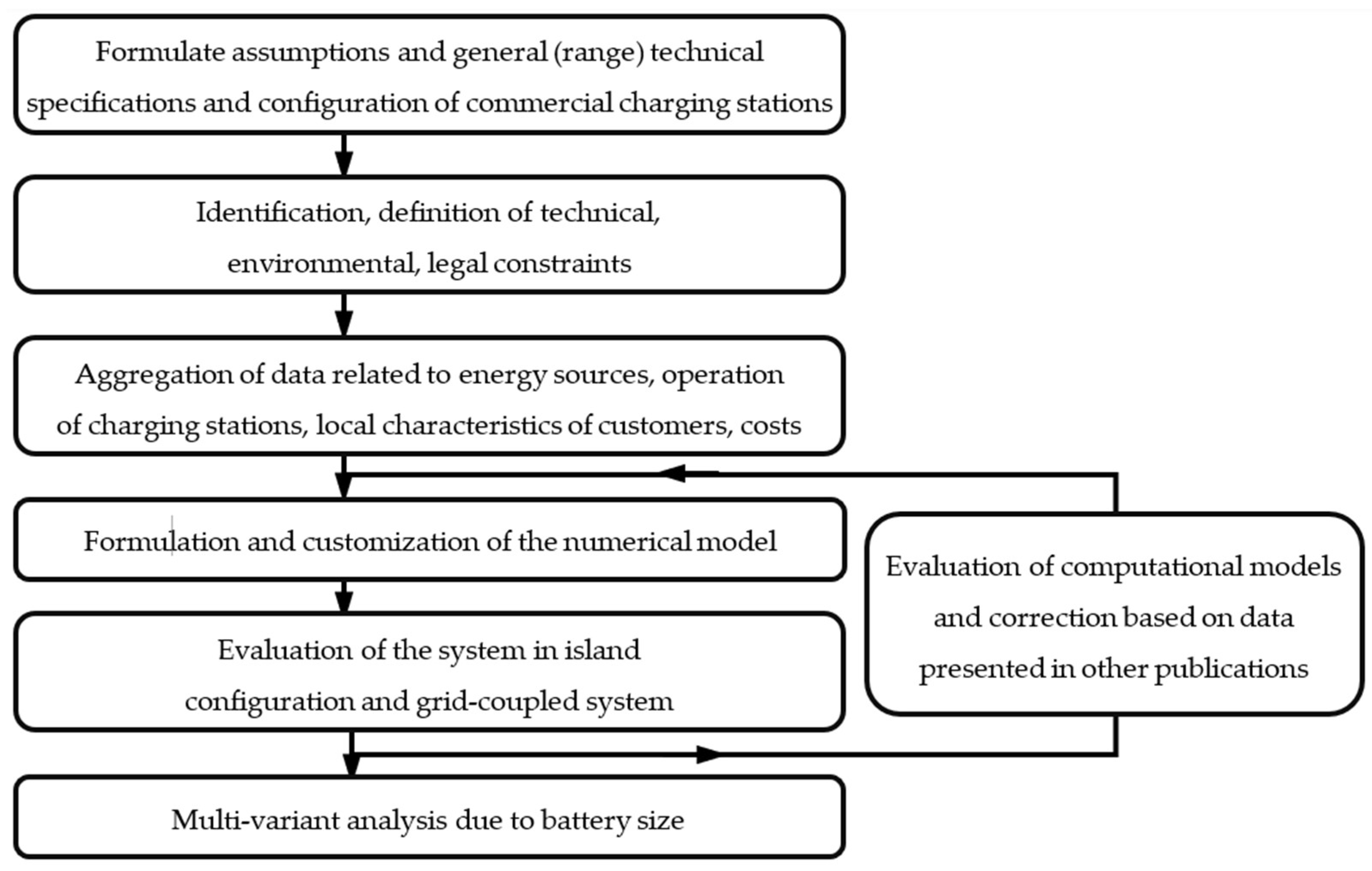
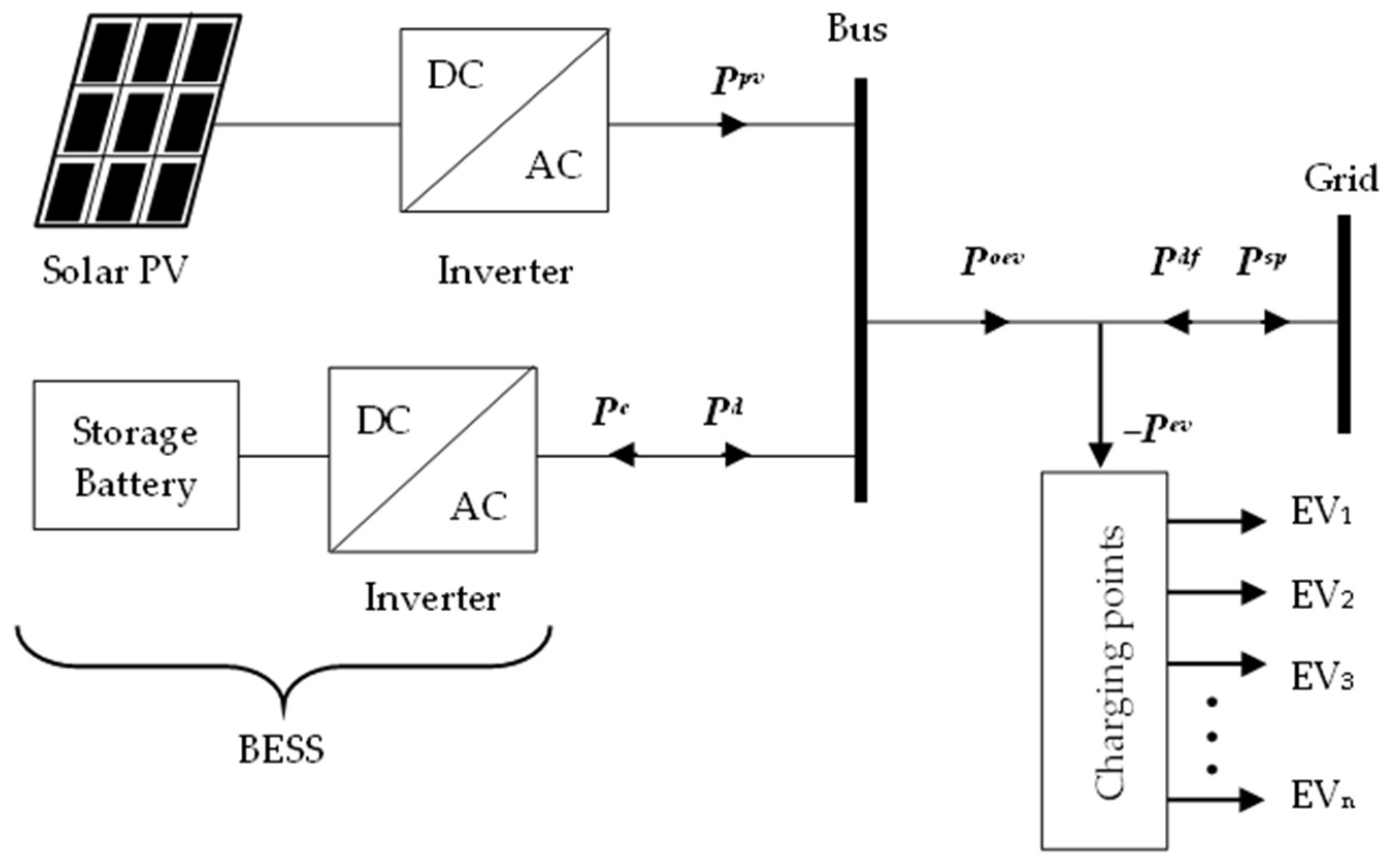
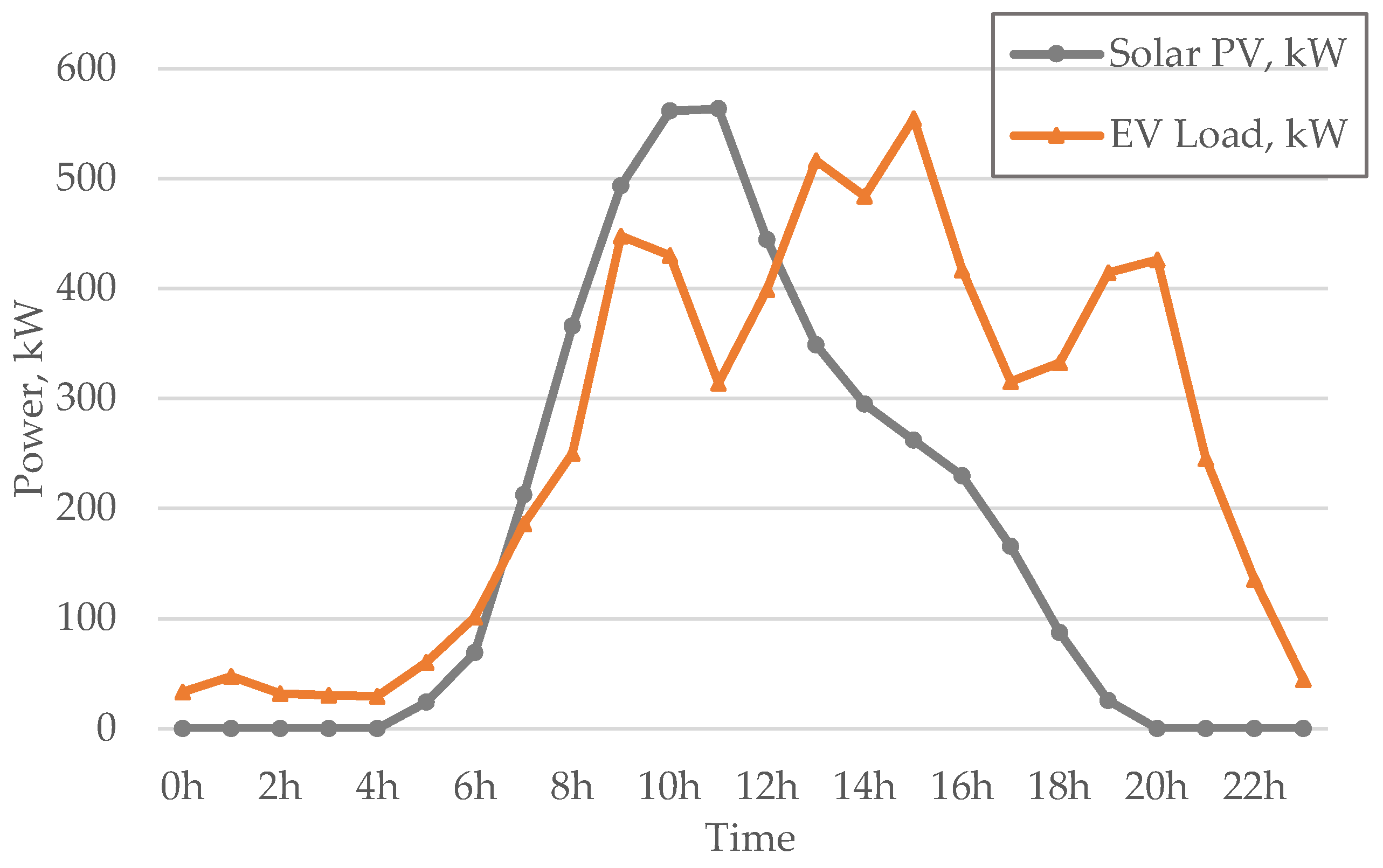
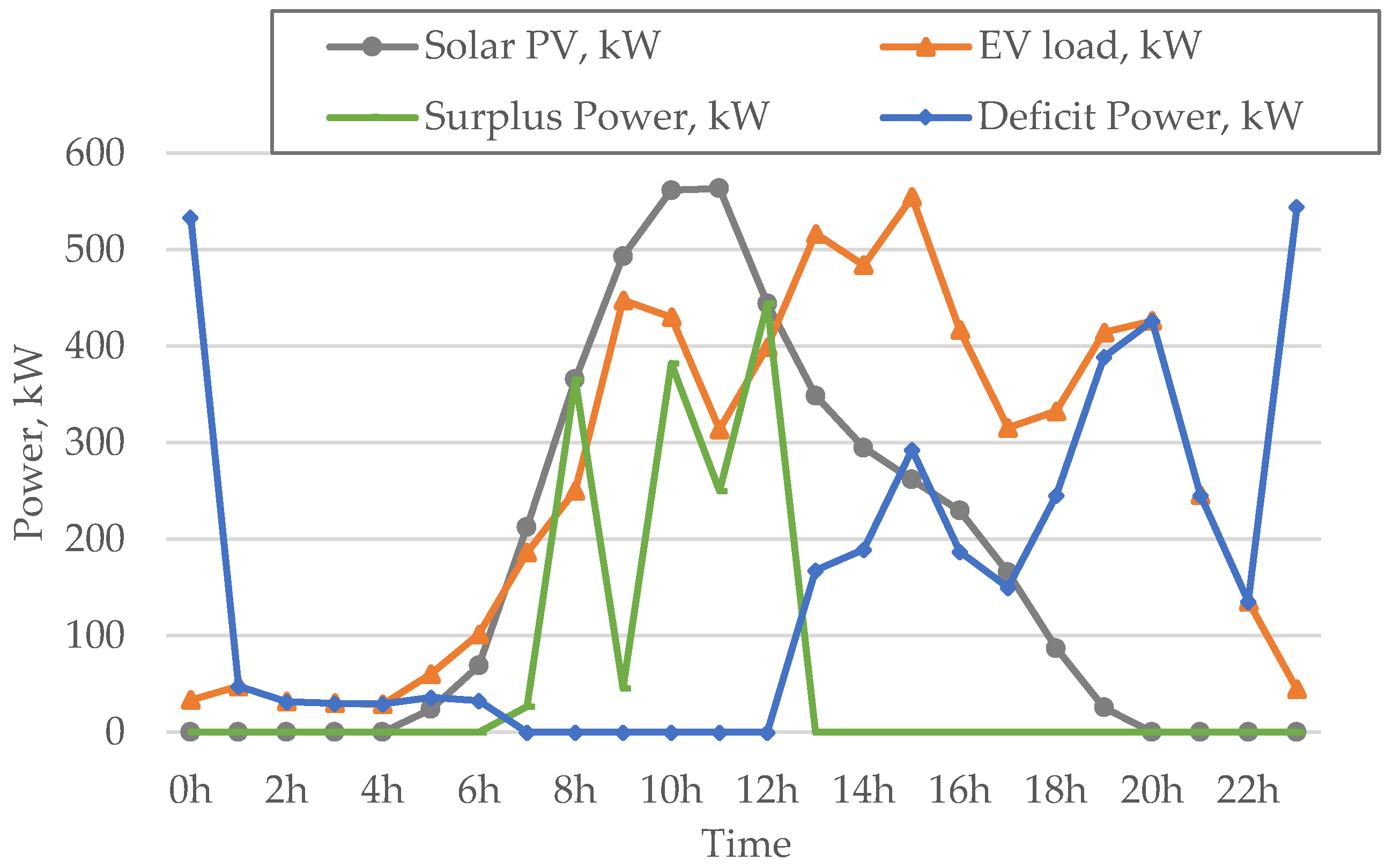
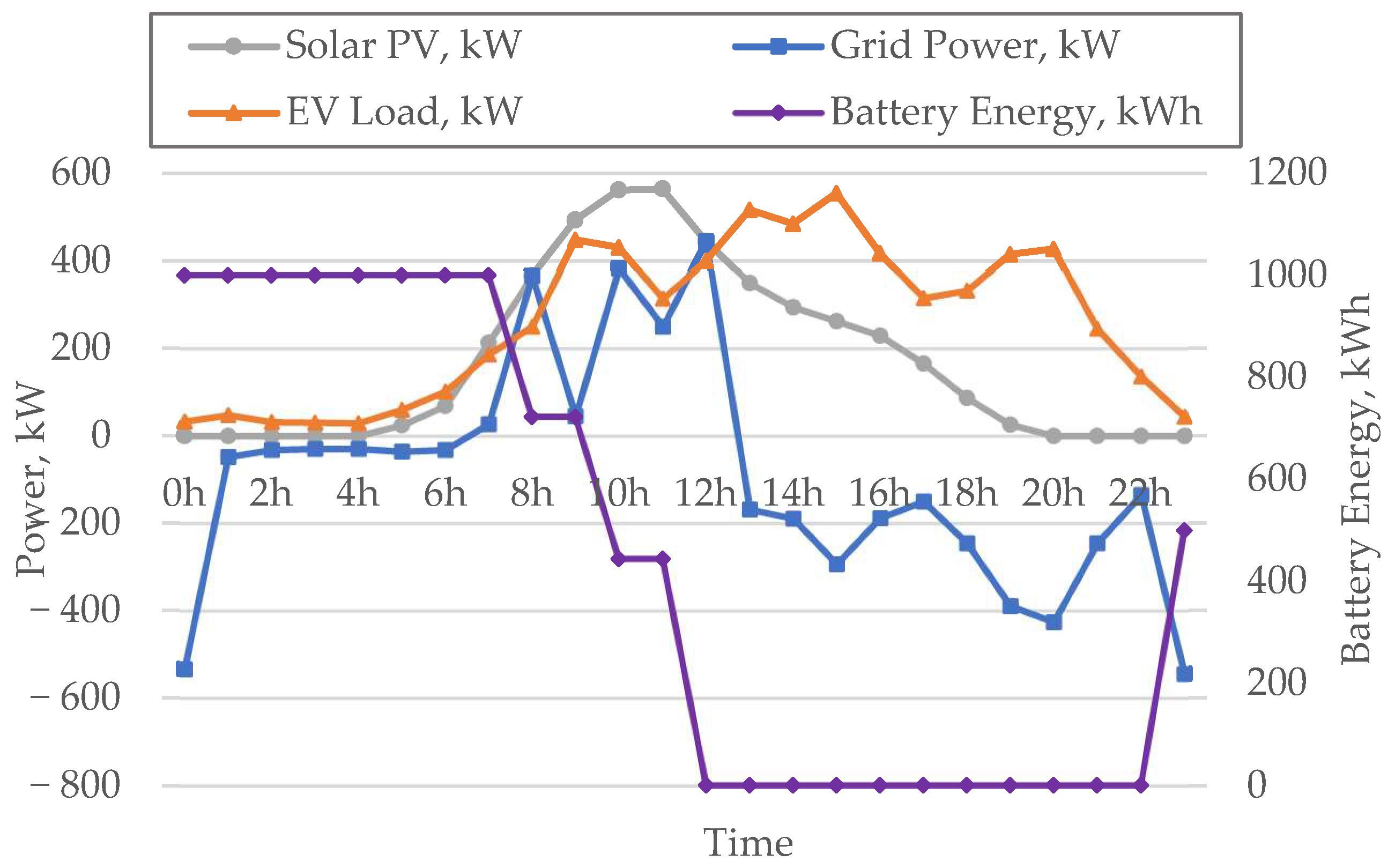
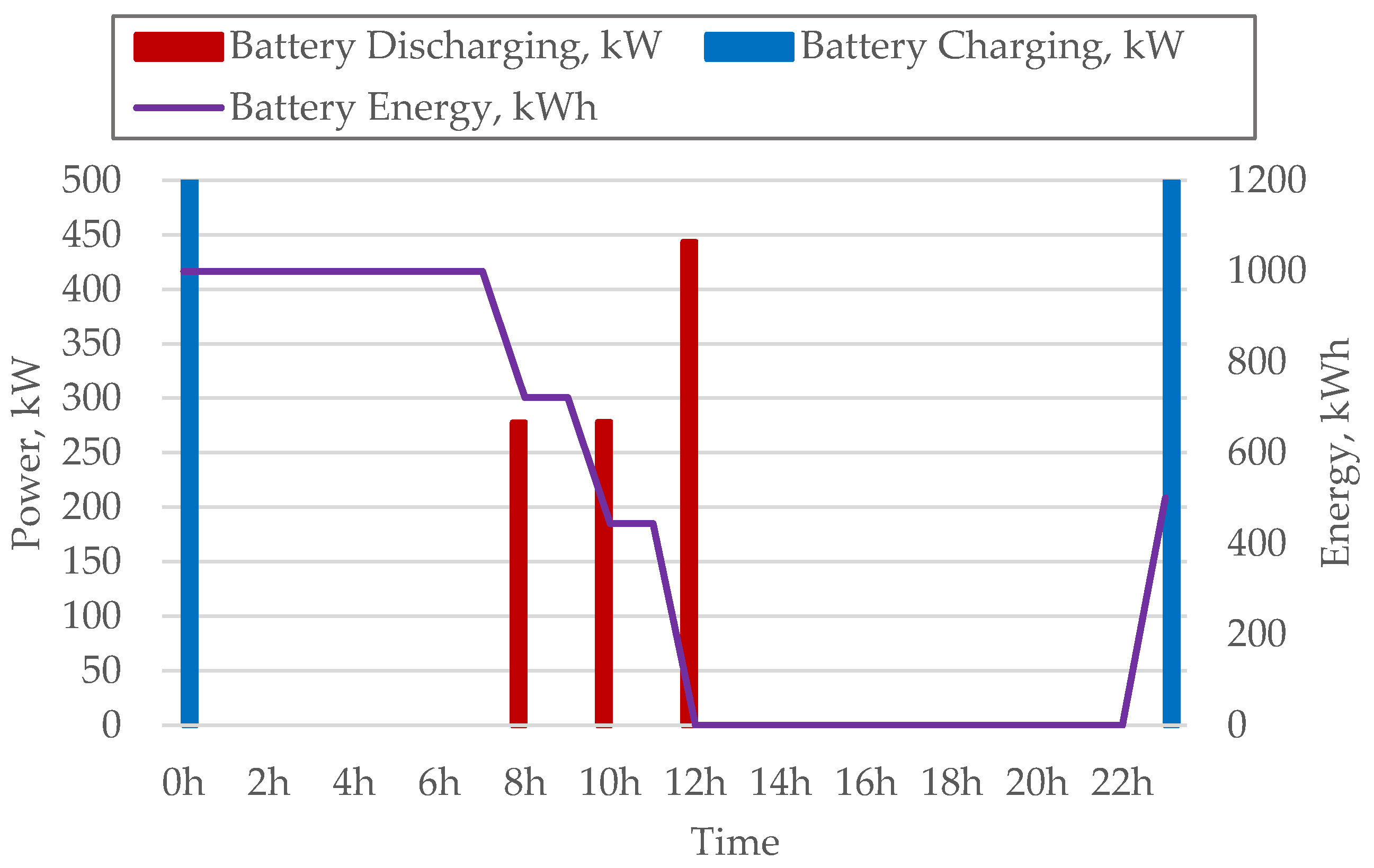
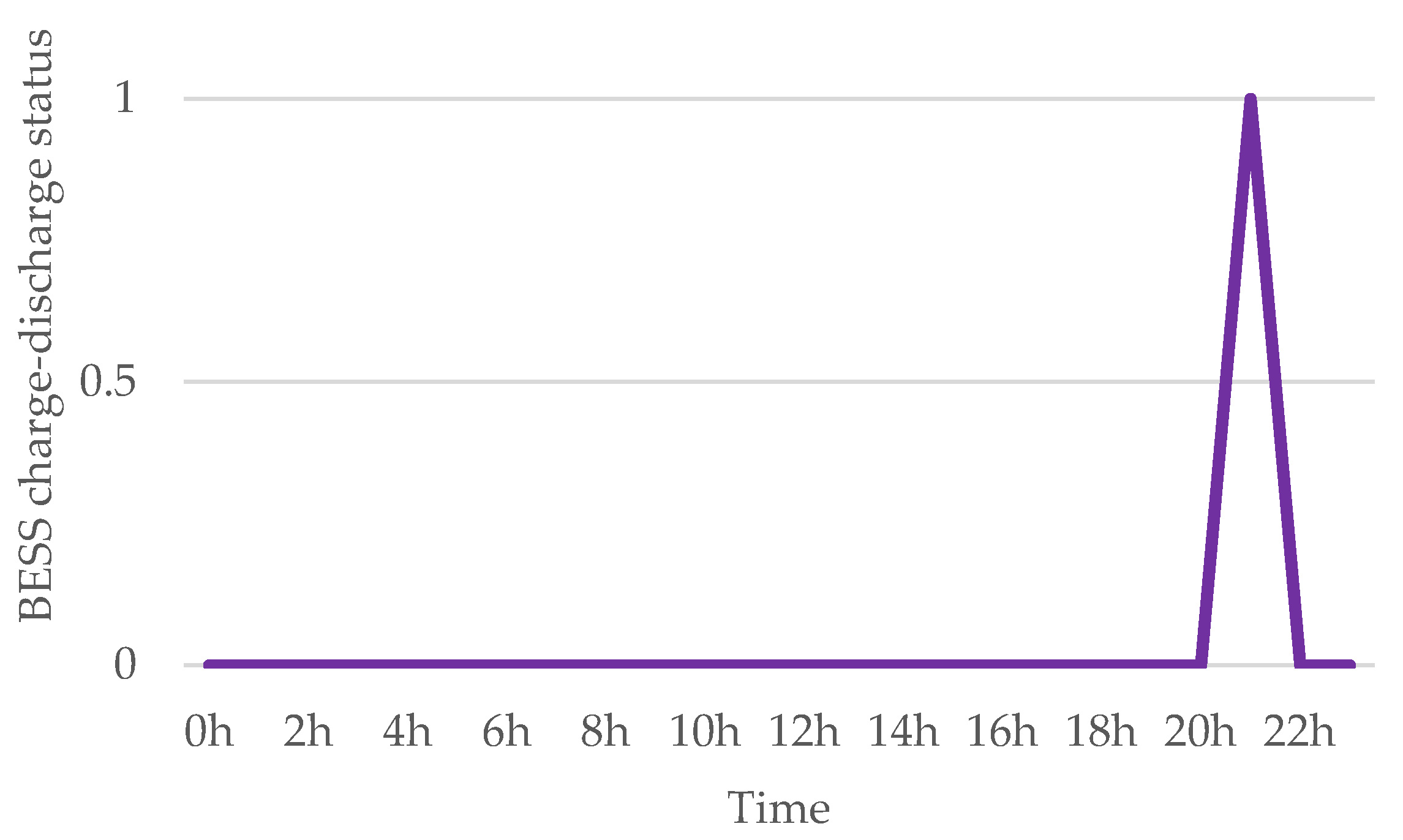
| Efficiency, (%) | 90 |
| Depth of discharge: DoD (%) | 80 |
| Battery size: (kWh) | 1000 |
| Time | 0 h | 1 h | 2 h | 3 h | 4 h | 5 h | 6 h | 7 h | 8 h | 9 h | 10 h | 11 h |
| EV arrival data from [32] | 282 | 402 | 269 | 251 | 246 | 503 | 850 | 1560 | 2100 | 3757 | 3612 | 2635 |
| (%) | 4.2 | 6.0 | 4.0 | 3.8 | 3.7 | 7.6 | 12.8 | 23.5 | 31.6 | 56.5 | 54.3 | 39.6 |
| Time | 12 h | 13 h | 14 h | 15 h | 16 h | 17 h | 18 h | 19 h | 20 h | 21 h | 22 h | 23 h |
| EV arrival data from [32] | 3354 | 4335 | 4063 | 4654 | 3498 | 2647 | 2795 | 3479 | 3577 | 2059 | 1135 | 374 |
| (%) | 50.4 | 65.2 | 61.1 | 70.0 | 52.6 | 39.8 | 42.0 | 52.3 | 53.8 | 31.0 | 17.1 | 5.6 |
| Off-Grid System—Profit Using Ref. [17] | Grid-Connected System—Profit |
|---|---|
| Not possible to optimize as the battery size is small. Violation of constraint Equation (21) | Deficit power is purchased from the grid, resulting in a profit of USD 3129.6 |
| Profit as per Ref. [17] | Profit—Proposed Method |
|---|---|
| USD 2674.3 | USD 3739 |
Disclaimer/Publisher’s Note: The statements, opinions and data contained in all publications are solely those of the individual author(s) and contributor(s) and not of MDPI and/or the editor(s). MDPI and/or the editor(s) disclaim responsibility for any injury to people or property resulting from any ideas, methods, instructions or products referred to in the content. |
© 2023 by the authors. Licensee MDPI, Basel, Switzerland. This article is an open access article distributed under the terms and conditions of the Creative Commons Attribution (CC BY) license (https://creativecommons.org/licenses/by/4.0/).
Share and Cite
Dukpa, A.; Butrylo, B.; Venkatesh, B. Comparative Analysis and Optimal Operation of an On-Grid and Off-Grid Solar Photovoltaic-Based Electric Vehicle Charging Station. Energies 2023, 16, 8086. https://doi.org/10.3390/en16248086
Dukpa A, Butrylo B, Venkatesh B. Comparative Analysis and Optimal Operation of an On-Grid and Off-Grid Solar Photovoltaic-Based Electric Vehicle Charging Station. Energies. 2023; 16(24):8086. https://doi.org/10.3390/en16248086
Chicago/Turabian StyleDukpa, Andu, Boguslaw Butrylo, and Bala Venkatesh. 2023. "Comparative Analysis and Optimal Operation of an On-Grid and Off-Grid Solar Photovoltaic-Based Electric Vehicle Charging Station" Energies 16, no. 24: 8086. https://doi.org/10.3390/en16248086
APA StyleDukpa, A., Butrylo, B., & Venkatesh, B. (2023). Comparative Analysis and Optimal Operation of an On-Grid and Off-Grid Solar Photovoltaic-Based Electric Vehicle Charging Station. Energies, 16(24), 8086. https://doi.org/10.3390/en16248086






